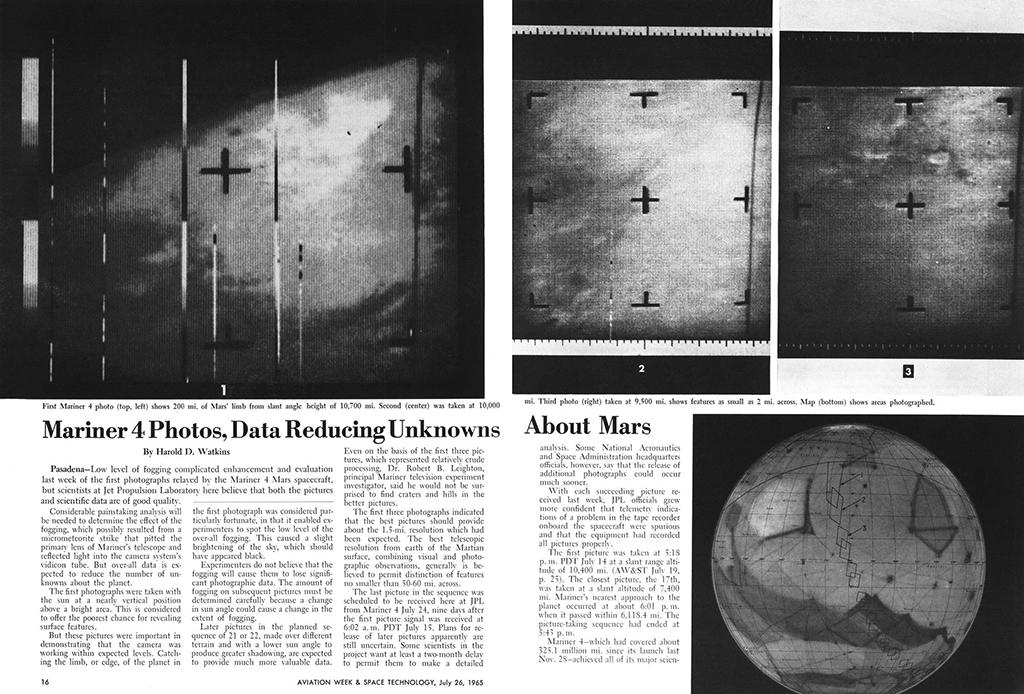
The Mariner 4 spacecraft took its first photographs of Mars—and the first of another planet from space—on July 14, 1965. The spacecraft, which had launched the previous November, passed within 6,118.4 mi. of the planet. Aviation Week reported that the first three photographs indicated the cameras would have a resolution as sharp as 1.5 mi., compared with a 50-60-mi. resolution from telescopes on Earth.

After numerous mission failures, the Soviet Union’s Mars 3 spacecraft entered into orbit around the planet in November 1971. A lander ejected from the spacecraft reached the planet’s surface but lost contact after a few seconds. “Either gradual settling into dust or a wind-whipped impact into rock outcroppings were offered by Soviet scientists as possible causes of the Mars 3 lander’s demise,” Aviation Week reported.

NASA’s Viking I lander was the first spacecraft to successfully land on Mars, touching down on July 20, 1976. Crisp black-and-white photos, the first ever taken from the Martian surface, ran in Aviation Week’s July 26 edition, unveiling “a panorama as desolate as that of the lunar landscape.”

“Color balancing of Viking 1 lander imagery with aid of test strip centered on spacecraft-mounted color chart produced what experimenters consider authentic rust-red Martian surface and peach-colored sky,” Aviation Week reported in its Aug. 9, 1976, edition.

NASA’s Mars Observer spacecraft was launched on Sept. 25, 1992, ending a 17-year gap in missions to the planet. The orbiter, pictured on Aviation Week’s cover the month before its launch, “is designed to act as a bridge between initial Mars exploration in the 1960s and 70s and preparations for human exploration of the planet envisioned for the early 21st century,” the magazine reported. The mission ended in failure when contact with the spacecraft was lost as it was about to enter orbit around Mars on Aug. 21, 1993.

NASA’s Mars Pathfinder achieved the first landing on the planet in 21 years on July 4, 1997, ending “a long dry spell in scientific exploration of the Red Planet and what could be the beginning of a groundswell of expanded knowledge about Mars,” Aviation Week reported. The magazine’s cover featured Pathfinder’s Sojourner rover, “the first vehicle to travel over the surface of another planet.”

Designed for a long-term study of Mars’ surface with unprecedented detail, NASA’s Mars Global Surveyor was launched on Nov. 7, 1996, and commenced its prime mapping mission in March 1999. Aviation Week’s Dec. 11, 2000, cover displayed a narrow-angle image from the mission of White Rock in Pollack Crater, illustrating “the discovery of what appears to be layered terrain that may have been deposited by water.” The spacecraft’s mission lasted until Nov. 14, 2006.

In 2003, NASA launched twin rovers, Spirit and Opportunity, to search for signs of past water on Mars. Aviation Week’s Feb. 2, 2004, cover story celebrated Opportunity’s successful landing in a small crater with robust scientific potential. The rover would send information back to Earth until 2018. The Spirit rover also far outlasted its planned 90-day mission, sending its final transmission in 2010. The missions revealed that Mars was wetter long ago and had conditions that could have sustained microbial life if any existed.

NASA’s Mars Science Laboratory Curiosity rover landed in Mars’ Gale Crater on Aug. 5, 2012, looking for evidence of past organic material and environments suitable to support microbial life.

NASA’s Perseverance rover touched down in Jezero Crater at 3:55 EST on Feb. 18 in a landing zone of just 4.8 X 4.1 mi., carrying a small helicopter named Ingenuity. In the next two years, Perseverance will be drilling Martian rock and collecting soil samples that may hold evidence of past microbial life. The samples will be cached and returned to Earth as early as 2031.
Aviation Week & Space Technology has covered numerous missions to Mars undertaken by the U.S., Soviet Union, India and—more recently—China and the United Arab Emirates. Following are some highlights from our digital archives.
